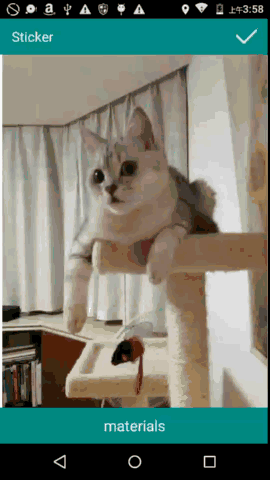前言
随着美图贴贴,天天P图,in的火热,越来越多的人喜欢贴图,朋友圈里的好友尤其是妹子喜欢把照片贴上各种搞怪或呆萌的道具。去年公司说要做一款主打原创素材的贴图应用,BB猪满怀欣喜的接下了这个任务,现在把贴图功能的具体实现分享出来。
需求
应用自带一部分默认素材,根据类别进入素材浏览界面,选中某一具体素材后,跳转至编辑界面,在编辑界面可对素材进行旋转,缩放,移动,删除操作,支持添加多个素材,最终保存。美图贴贴界面如下:
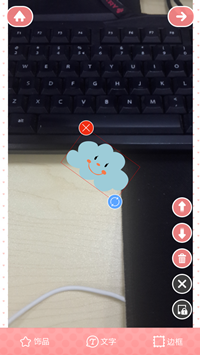
分析
BB猪冥思一想,有了初步方案:使用自定义View去实现道具的旋转,缩放,移动等基本操作。
自定义一个贴图控件StickerView,继承至View。StickerView模型图如下:
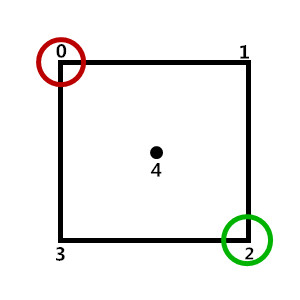
先定义4个常量分别表示:左上角删除按钮,右下角旋转缩放按钮,中心点,其他点。
public static final int CTR_LEFT_TOP = 0;
public static final int CTR_RIGHT_BOTTOM = 2;
public static final int CTR_MID_MID = 4;
public static final int CTR_NONE = -1;
public int current_ctr = CTR_NONE;
定义3个Bitmap:mainBmp , deleteBmp ,controlBmp分别对应素材图本身,删除按钮和旋转缩放按钮。
private Bitmap mainBmp , deleteBmp ,controlBmp ;
private int mainBmpWidth , mainBmpHeight , deleteBmpWidth , deleteBmpHeight , controlBmpWidth , controlBmpHeight ;
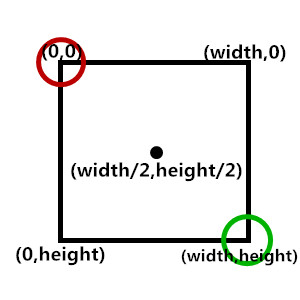
定义两个数组srcPs和dstPs,分别用于记录矩形转换(旋转,移动,缩放)前后的各点坐标。
private float[] srcPs, dstPs;
看下构造器,构造器中主要做两件事:传入素材图url和调用初始化方法initData
public StickerView(Context context , String imgPath){
super(context);
this.context = context ;
this.imgPath = imgPath;
initData(imgPath);
}
initData方法主要是初始化Bitmap和坐标数组:
private void initData(String imgPath) {
mainBmp = BitmapFactory.decodeFile(imgPath);
deleteBmp = BitmapFactory.decodeResource(this.context.getResources(), R.drawable.ic_f_delete_normal);
controlBmp = BitmapFactory.decodeResource(this.context.getResources(), R.drawable.ic_f_rotate_normal);
mainBmpWidth = mainBmp.getWidth();
mainBmpHeight = mainBmp.getHeight();
deleteBmpWidth = deleteBmp.getWidth();
deleteBmpHeight = deleteBmp.getHeight();
controlBmpWidth = controlBmp.getWidth();
controlBmpHeight = controlBmp.getHeight();
srcPs = new float[]{
0, 0,
mainBmpWidth, 0,
mainBmpWidth, mainBmpHeight,
0, mainBmpHeight,
mainBmpWidth / 2, mainBmpHeight / 2
};
dstPs = srcPs.clone();
matrix = new Matrix();
// 平移后中心点位置
prePivot = new Point(mainBmpWidth / 2, mainBmpHeight / 2);
// 平移前中心点位置
lastPivot = new Point(mainBmpWidth / 2, mainBmpHeight / 2);
// 上一次触摸点位置
lastPoint = new Point(0, 0);
paint = new Paint();
paintFrame = new Paint();
paintFrame.setColor(Color.WHITE);
paintFrame.setAntiAlias(true);
defaultDegree = lastDegree = computeDegree(new Point(mainBmpWidth, mainBmpHeight), new Point(mainBmpWidth / 2, mainBmpHeight / 2));
setMatrix(OPER_DEFAULT);
}
接下来看一下StickerView的绘制流程:
定义一个标志位isSelected,如果处于选中状态就显示边框和操作按钮,反之不显示。
public void onDraw(Canvas canvas) {
if (!isActive) {
return;
}
canvas.drawBitmap(mainBmp, matrix, paint);//绘制主图片
if (isSelected) {
drawFrame(canvas);//绘制边框,以便测试点的映射
drawControlPoints(canvas);//绘制控制点图片
}
}
绘制边框
private void drawFrame(Canvas canvas) {
canvas.drawLine(dstPs[0], dstPs[1], dstPs[2], dstPs[3], paintFrame);
canvas.drawLine(dstPs[2], dstPs[3], dstPs[4], dstPs[5], paintFrame);
canvas.drawLine(dstPs[4], dstPs[5], dstPs[6], dstPs[7], paintFrame);
canvas.drawLine(dstPs[0], dstPs[1], dstPs[6], dstPs[7], paintFrame);
}
绘制操作按钮
private void drawControlPoints(Canvas canvas) {
canvas.drawBitmap(deleteBmp, dstPs[0] - deleteBmpWidth / 2, dstPs[1] - deleteBmpHeight / 2, paint);
canvas.drawBitmap(controlBmp, dstPs[4] - controlBmpWidth / 2, dstPs[5] - controlBmpHeight / 2, paint);
}
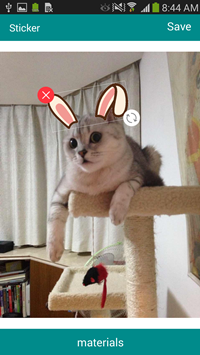
接下来就是重点了,StickerView的Touch事件处理:
若触摸点不在StickerView上并且不在删除按钮和旋转按钮上,则将StickerView设置为非选中状态并隐藏边框和操作按钮;
若触摸点在删除按钮上,则隐藏该素材;
若触摸点在旋转缩放按钮处,则进行旋转缩放操作;
若触摸点在StickerView的其他位置,则进行移动操作。
public boolean onTouchEvent(MotionEvent event) {
int evX = (int) event.getX();
int evY = (int) event.getY();
if (!isOnPic(evX, evY) && isOnCP(evX, evY) == CTR_NONE) {
isSelected = false;
invalidate();
} else if (isOnCP(evX, evY) == CTR_LEFT_TOP) {
isActive = false;
invalidate();
} else {
int operType = OPER_DEFAULT;
operType = getOperationType(event);
switch (operType) {
case OPER_TRANSLATE:
if (isOnPic(evX, evY)) {
translate(evX, evY);
}
break;
case OPER_ROTATE:
rotate(event);
scale(event);
break;
}
lastPoint.x = evX;
lastPoint.y = evY;
lastOper = operType;
isSelected = true;
invalidate();
}
return true;
}
判断触摸点是否在贴图上
private boolean isOnPic(int x, int y) {
// 获取逆向矩阵
Matrix inMatrix = new Matrix();
matrix.invert(inMatrix);
float[] tempPs = new float[]{0, 0};
inMatrix.mapPoints(tempPs, new float[]{x, y});
if (tempPs[0] > 0 && tempPs[0] < mainBmp.getWidth() && tempPs[1] > 0 && tempPs[1] < mainBmp.getHeight()) {
return true;
} else {
return false;
}
}
判断点所在的控制点
private int isOnCP(int evx, int evy) {
Rect rect = new Rect(evx - controlBmpWidth / 2, evy - controlBmpHeight / 2, evx + controlBmpWidth / 2, evy + controlBmpHeight / 2);
int res = 0;
for (int i = 0; i < dstPs.length; i += 2) {
if (rect.contains((int) dstPs[i], (int) dstPs[i + 1])) {
return res;
}
++res;
}
return CTR_NONE;
}
定义StickerView的操作类型:移动,旋转,缩放,选择
public static final int OPER_DEFAULT = -1; //默认
public static final int OPER_TRANSLATE = 0; //移动
public static final int OPER_SCALE = 1; //缩放
public static final int OPER_ROTATE = 2; //旋转
public static final int OPER_SELECTED = 3; //选择
public int lastOper = OPER_SELECTED;
private int getOperationType(MotionEvent event) {
int evX = (int) event.getX();
int evY = (int) event.getY();
int curOper = lastOper;
switch (event.getAction()) {
case MotionEvent.ACTION_DOWN:
current_ctr = isOnCP(evX, evY);
if (current_ctr != CTR_NONE || isOnPic(evX, evY)) {
curOper = OPER_SELECTED;
}
break;
case MotionEvent.ACTION_MOVE:
if (current_ctr == CTR_LEFT_TOP) {
// 删除饰品
} else if (current_ctr == CTR_RIGHT_BOTTOM) {
curOper = OPER_ROTATE;
} else if (lastOper == OPER_SELECTED) {
curOper = OPER_TRANSLATE;
}
break;
case MotionEvent.ACTION_UP:
curOper = OPER_SELECTED;
break;
default:
break;
}
return curOper;
}
通过Matrix实现移动,旋转,缩放:
private void translate(int evx, int evy) {
prePivot.x += evx - lastPoint.x;
prePivot.y += evy - lastPoint.y;
deltaX = prePivot.x - lastPivot.x;
deltaY = prePivot.y - lastPivot.y;
lastPivot.x = prePivot.x;
lastPivot.y = prePivot.y;
setMatrix(OPER_TRANSLATE); //设置矩阵
}
private void scale(MotionEvent event) {
int pointIndex = current_ctr * 2;
float px = dstPs[pointIndex];
float py = dstPs[pointIndex + 1];
float evx = event.getX();
float evy = event.getY();
float oppositeX = 0;
float oppositeY = 0;
oppositeX = dstPs[pointIndex - 4];
oppositeY = dstPs[pointIndex - 3];
float temp1 = getDistanceOfTwoPoints(px, py, oppositeX, oppositeY);
float temp2 = getDistanceOfTwoPoints(evx, evy, oppositeX, oppositeY);
this.scaleValue = temp2 / temp1;
symmetricPoint.x = (int) oppositeX;
symmetricPoint.y = (int) oppositeY;
centerPoint.x = (int) (symmetricPoint.x + px) / 2;
centerPoint.y = (int) (symmetricPoint.y + py) / 2;
rightBottomPoint.x = (int) dstPs[8];
rightBottomPoint.y = (int) dstPs[9];
Log.i("img", "scaleValue is " + scaleValue);
if (getScaleValue() < (float) 0.5 && scaleValue < (float) 1) {
// 限定最小缩放比为0.5
} else {
setMatrix(OPER_SCALE);
}
}
private void rotate(MotionEvent event) {
if (event.getPointerCount() == 2) {
preDegree = computeDegree(new Point((int) event.getX(0), (int) event.getY(0)), new Point((int) event.getX(1), (int) event.getY(1)));
} else {
preDegree = computeDegree(new Point((int) event.getX(), (int) event.getY()), new Point((int) dstPs[8], (int) dstPs[9]));
}
setMatrix(OPER_ROTATE);
lastDegree = preDegree;
}
private void setMatrix(int operationType) {
switch (operationType) {
case OPER_TRANSLATE:
matrix.postTranslate(deltaX, deltaY);
break;
case OPER_SCALE:
matrix.postScale(scaleValue, scaleValue, dstPs[CTR_MID_MID * 2], dstPs[CTR_MID_MID * 2 + 1]);
break;
case OPER_ROTATE:
matrix.postRotate(preDegree - lastDegree, dstPs[CTR_MID_MID * 2], dstPs[CTR_MID_MID * 2 + 1]);
break;
}
matrix.mapPoints(dstPs, srcPs);
}
最后看下素材的添加保存流程:在主界面点击素材按钮进入素材选择界面,选中素材后通过onActivityResult获取图片url,初始化StickerView,并通过addView方法添加至容器中,并通过ArrayList
private Bitmap createBitmap(Bitmap src, Bitmap dst, float[] centerPoint, float degree, float scaleValue) {
if (src == null) {
return null;
}
int w = src.getWidth();
int h = src.getHeight();
DisplayMetrics metric = new DisplayMetrics();
getWindowManager().getDefaultDisplay().getMetrics(metric);
int width = metric.widthPixels; // 屏幕宽度(像素)
float scale = (float) w / (float) width;
int ww = dst.getWidth();
int wh = dst.getHeight();
float Ltx = centerPoint[0] - img.getLeft() - ww * scaleValue / 2;
float Lty = centerPoint[1] - img.getTop() - wh * scaleValue / 2;
Bitmap newb = Bitmap.createBitmap(w, h, Bitmap.Config.ARGB_8888);//创建一个新的和SRC长度宽度一样的位图
Canvas cv = new Canvas(newb);
cv.drawBitmap(src, 0, 0, null);//在 0,0坐标开始画入src
// 定义矩阵对象
Matrix matrix = new Matrix();
matrix.postScale(scaleValue, scaleValue);
//matrix.postRotate(degree);
cv.save();
cv.rotate(degree, centerPoint[0], centerPoint[1]);
Bitmap dstbmp = Bitmap.createBitmap(dst, 0, 0, dst.getWidth(), dst.getHeight(),
matrix, true);
cv.drawBitmap(dstbmp, Ltx * scale, Lty * scale, null);//在src画贴图
//cv.save( Canvas.ALL_SAVE_FLAG );//保存
cv.restore();//存储
return newb;
}
项目地址:https://github.com/ckj375/Android-Sticker.git
效果图:
